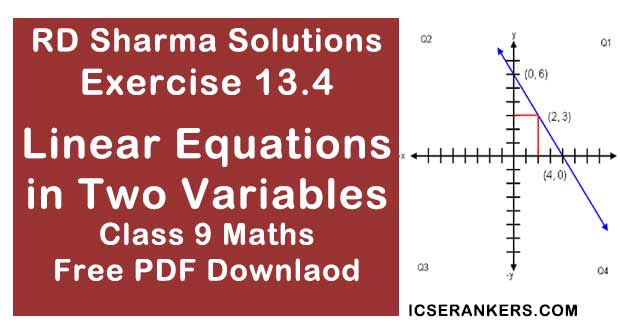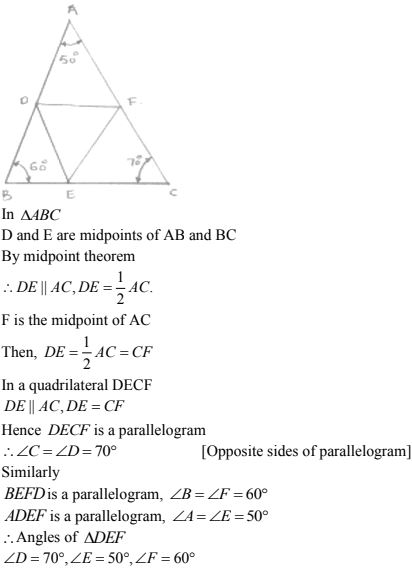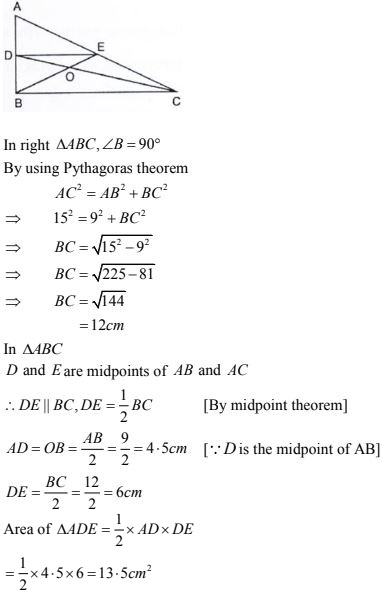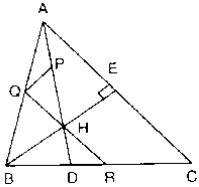Chapter 14 Quadrilaterals RD Sharma Solutions Exercise 14.4 Class 9 Maths

Chapter Name | RD Sharma Chapter 14 Quadrilaterals Exercise 14.4 |
Book Name | RD Sharma Mathematics for Class 10 |
Other Exercises |
|
Related Study | NCERT Solutions for Class 10 Maths |
Exercise 14.4 Solutions
1. In a ΔABC, D, E and F are, respectively, the mid - point of BC, CA and AB. If the length of side AB, BC and CA are 7cm, 8cm and 9cm, respectively, find the perimeter of ΔDEF.
Solution

2. In a triangle ∠ABC, ∠A = 50°, ∠B = 60° and ∠C = 70° . Find the measure of the angles of the triangle formed by joining the mid - points of the sides of this triangle .
Solution

3. In a triangle, P, Q and R are the mid - points of sides BC, CA and AB respectively. If AC = 21cm, BC = 29cm and AB = 30 cm, find the perimeter of the quadrilateral ARPQ.
Solution

4. In a ΔABC median AD is produced to X such that AD = DX. Prove that ABXC is a parallelogram.
Solution

In a quadrilateral ABXC, we have
AD = DX [Given]
BD = DC [Given]
So, diagonals AX and BC bisect each other BD = DC [Given]
∴ ABXC is a parallelogram
5. In a ΔABC, E and F are the mid - points of AC and AB respectively. The altitude AP to BC intersects FE at Q. Prove that AQ = QP.
Solution

In ΔABC
E and F are midpoints of AB and AC
∴ EF || FE, 1/2 BC = FE [∵ By mid - point theorem]
In ΔABP,
F is the midpoint of AB and FQ || BP [∵ EF || BC]
∴ Q is the midpoint of AP [By converse of midpoint theorem]
∴ Q is the midpoint of AP [By converse of midpoint theorem]
Hence, AQ = QP
6. In a ΔABC, BM and CN are perpendiculars from B and C respectively on any line passing through A. If L is the mid - point of BC, prove that ML = NL.
Solution

7. In Fig. below, triangle ABC is right - angled at B. Given that AB = 9cm, AC = 15 cm and D, E are the mid - points of the sides AB and AC respectively, calculate
(i) The length of BC
(ii) The area of ΔADE.

Solution

8. In fig. below, M, N and P are the mid - points of AB, AC and BC respectively. If MN = 3 cm, NP = 3.5 cm and MP = 2.5 cm, calculate BC, AB and AC.

Solution

9. ABC is a triangle and through A, B, C lines are drawn parallel to BC, CA and AB respectively intersecting at P, Q and R . Prove that the perimeter of ΔPQR is double the perimeter of ΔABC.
Solution

10. In Fig. below, BE ⊥ AC. AD is any line from A to BC intersecting BE in H. P, Q and R are respectively the mid - points of AH, AB and BC. Prove that ∠PQR = 90° .

Solution

11. In Fig. below, AB = AC and CP || BA and AP is the bisector of exterior ∠CAD of ΔABC.
Prove that:
(i) ∠PAC = ∠BCA
(ii) ABCP is a parallelogram .

Solution

12. ABCD is a kite having AB = AD and BC = CD. Prove that the figure formed by joining the mid-points of the sides, in order, is a rectangle.
Solution

Given,
A kite ABCD having AB = AD and BC = CD. P,Q,R,S are the midpoint of sides AB, BC, CD and DA respectively PQ, QR, RS and spare joined
To prove :
PQRS is a rectangle
Proof:
In ΔABC, P and Q are the midpoints of AB and BC respectively.
∴ PQ || AC and PQ = 1/2 AC ...(i)
In ΔADC, R and S are the midpoint of CD and AD respectively .
In ΔADC, R and S are the midpoint of CD and AD respectively .
∴ RS || AC and RS = 1/2 AC ...(ii)
From (i) and (ii), we have
From (i) and (ii), we have
PQ || RS and PQ = RS
Thus, in quadrilateral PQRS, a pair of opposite sides are equal and parallel. So PQRS is a parallelogram. Now, we shall prove that one angle of parallelogram PQRS it is a right angle
Since AB = AD

13. Let ABC be an isosceles triangle in which AB = AC. If D, E, F be the mid - points of the sides BC, CA and AB respectively. Show that the segment AD and EF bisect each other at right angles. 



 (i) In ΔADC, Q is the midpoint of AC such that
(i) In ΔADC, Q is the midpoint of AC such that 

∴ The lines BM, LS and CN being the same perpendiculars, on line MN are parallel to each other.

Let ABCD is a quadrilateral in which P, Q, R and S are midpoints of sides
Solution

14. ABC is a triangle. D is a point on AB such that AD = 1/4 AB and E is a point on AC such that AE = 1/4 AC. Prove that DE = 1/4 BC.
Let P and Q be the midpoints of AB and AC respectively.
Solution

Let P and Q be the midpoints of AB and AC respectively.
Then PQ || BC such that
PQ = 1/2 BC ...(i)
In ΔAPQ, D and E are the midpoint of AP and AQ are respectively
In ΔAPQ, D and E are the midpoint of AP and AQ are respectively

15. In below Fig, ABCD is a parallelogram in which P is the mid - point of DC and q is a point on AC such that CQ = 1/4 AC. If PQ produced meets BC at R, prove that R is a mid - point of BC.

Solution

16. In the below Fig, ABCD and PQRC are rectangles and Q is the mid - point of AC. Prove that
(i) DP = PC
(ii) PR = 1/2 AC
(i) DP = PC
(ii) PR = 1/2 AC

Solution

PQ || AD
∴ P is the midpoint of DC
⇒ DP = DC [Using converse of midpoint theorem]
(ii) Similarly, R is the midpoint of BC
(ii) Similarly, R is the midpoint of BC
∴ PR = 1/2 BD
PR = 1/2 AC [Diagonal of rectangle are equal ∴ BD = AC]
17. ABCD is a parallelogram, E and F are the mid - points of AB and CD respectively. GH is any line intersecting AD, EF and BC at G, P and H respectively. Prove that GP = PH.
PR = 1/2 AC [Diagonal of rectangle are equal ∴ BD = AC]
Solution

18. BM and CN are perpendiculars to a line passing through the vertex A of a triangle ABC. If L is the mid - point of BC, prove that LM = LN.
Solution
To prove LM = LN
Draw LS perpendicular to line MN

∴ The lines BM, LS and CN being the same perpendiculars, on line MN are parallel to each other.
According to intercept theorem,
If there are three or more parallel lines and the intercepts made by them on a transversal or equal. Then the corresponding intercepts on any other transversal are also equal.
In the drawn figure, MB and LS and NC are three parallel lines and the two transversal line are MN and BC
In the drawn figure, MB and LS and NC are three parallel lines and the two transversal line are MN and BC
We have, BL = LC (As L is the given midpoint of BC)
∴ using intercept theorem, we get
∴ using intercept theorem, we get
MS = SN ...(i)
Now in ΔMLS and LSN
Now in ΔMLS and LSN
MS = SN [using ...(i)]
∠LSM = ∠LSN = 90° (LS ⊥ MN and SL = LS common)
∴ ΔMLS ≅ ΔLSN (SAS congruency theorem)
∴ LM = LN (CPCT)
∴ LM = LN (CPCT)
19. Show that the line segment joining the mid - points of the opposite sides of a quadrilateral bisect each other.
Solution

Let ABCD is a quadrilateral in which P, Q, R and S are midpoints of sides
AB, BC, CD and DA respectively join PQ, QR, RS, SP and BD
In ΔABD, S and P are the midpoints of AD and AB respectively.
So, by using midpoint theorem we can say that
So, by using midpoint theorem we can say that
SP || BD and SP = 1/2 BD ...(1)
Similarly in ΔBCD
QR || BD and QR = 1/2BD ...(2)
From equation (1) and (2) we have
Similarly in ΔBCD
QR || BD and QR = 1/2BD ...(2)
From equation (1) and (2) we have
SP || QR and SP = QR
As in quadrilateral SPQR one pair of opposite side are equal and parallel to each other.
As in quadrilateral SPQR one pair of opposite side are equal and parallel to each other.
So, SPQR is parallelogram
Since, diagonals of a parallelogram bisect each other.
Hence PR and QS bisect each other.
20. Fill in the blanks to make the following statements correct:
(i) The triangle formed by joining the mid-points of the sides of an isosceles triangle is ____
(ii) The triangle formed by joining the mid-points of the sides of a right triangle is ______
(iii) The figure formed by joining the mid-points of consecutive sides of a quadrilateral is _____
Solution
(i) Isosceles
(ii) Right triangle
(iii) Parallelogram
